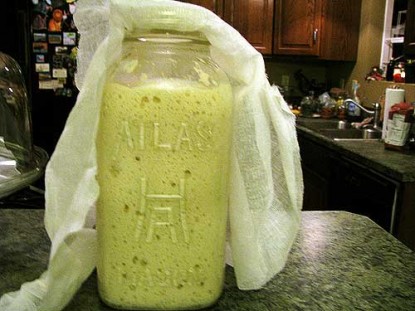
Who doesn’t love sourdough bread? You can make it at home easily. Most of us think of San Francisco-style sourdough when we hear the words sourdough bread, but sourdough is a type of riser, not a type of bread, which adds a distinctively tangy flavor to the end product. Any bread recipe can be converted to sourdough.
Difficulty: Easy
Servings: varies
Prep Time: 5 minutesIngredients
1 tablespoon (1 packet) yeast (not rapid-rise)
1/2 cup warm water
1 1/2 cups all-purpose flour
1 1/2 more cups warm water
1 tablespoon sugar or honey
Directions
If you want to really go crazy, catch some wild yeast. You need a horse and a lasso–- Okay, not really. You need a big jar or bowl (non-metal), 1 1/2 cups of warm water and 2 cups of flour. Stir it up good then let it sit covered with only a mesh material (to allow air flow into the container) while you “catch” natural micro-organisms from the air.
If you’re like me and you have cats who will bother your container or you aren’t feeling frisky enough to lasso yourself some yeast from the wild, you can take a packet (or a tablespoon) of regular everyday “pre-captured” yeast from the store and go from there.
In a large (non-metal) bowl, dissolve yeast in the 1/2 cup of water. Add flour, additional water, and the sugar or honey. Beat till blended. You can leave it in the bowl to ferment, or transfer it to a large jar.
I use a 2-quart jar. You have to use a large bowl or a large jar because the starter needs room to bubble up and expand. Cover the top with cheesecloth. I use a jar band to keep the cheesecloth on there good. Let stand at room temperature in a warm place while it ferments. I keep it on the kitchen counter as that’s the warmest room in the house most of the time. Depending on the temperature in your house, it will take 5-10 days to ferment. Stir the mixture 2 or 3 times a day. It should be kinda like pancake batter in consistency (after stirring). It may separate some and look goopy as it sits. Just keep stirring it up a couple times a day.
You’ll know it’s ready when you walk by it one day and think, Is there some beer in here? Then you look around and realize it’s the starter. Once the starter is ready, you can store it in the refrigerator. (Continue to cover with cheesecloth. You can use a rubberband, or a jar ring, etc, but do not seal it shut.) Stir it once a day.
After each use of the starter, replenish it by stirring in another 1/2 cup warm water, 1/2 cup flour, and another teaspoon of sugar or honey. Allow starter to sit out for a day to ferment before putting back in the refrigerator. Wait at least a couple days before using the starter again. If you don’t use the starter for 10 days, stir in a teaspoon of sugar or honey to keep it active and stick it back in the fridge.
Never take more than two uses of the starter at a time. Each use is 2/3 cup starter per one loaf recipe. You can take out double that (1 1/3 cups) if making two loaves, and in that case replenish double, but no more than that or you’ll wear your starter down pretty quickly. (If you need to make more sourdough bread than that at a time, you might want to run two pots.)
You can keep your starter going for a long time if you take care of it. If you don’t and if you screw it up, just start over. It’s just yeast, water, sugar, and flour. It’s okay. If your house is very cold, it will not work. I tried to get some starter going one winter at the old farmhouse and it just sat there. Then I set it in front of the gas fireplace and it fried. There was no winning for losing there. I keep my new farmhouse at 67 degrees in the winter and it takes about a week to get starter going here, so unless you live in a freezing, drafty old farmhouse, you can probably ferment starter any time of the year. If you do live in a freezing, drafty old farmhouse, may I just say, I feel your pain and wait till spring to make starter. (I loved that old house anyway!)
Note: Always bring your starter to room temperature before using it in a recipe.
See how to make sourdough Grandmother Bread here.
Categories: Breads, Sourdough, Yeast Breads
Submitted by: suzanne-mcminn on July 31, 2010




Add Your Thoughts
You must be logged in to post a comment.